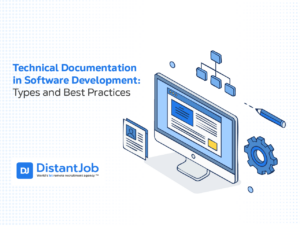The ability to work remotely can be a dream come true for employees while simultaneously boosting a company’s bottom line and talent reach. Leveraging the full potential of this work style requires clear and well-defined expectations on both sides of the relationship. A remote work policy provides exactly that.
Here’s how to put together a detailed, clear, and supportive remote work arrangement that meets your company’s operational needs and your employee’s well-being. Let’s start by defining a remote work policy.
What is a Remote Work Policy?
A remote work policy outlines some rules for remote employees. It is an agreement that contains information such as where and when the remote employee can work outside the office.
Remember that a good remote work policy is about enabling, not restricting. It doesn’t try to take away the flexibility that accompanies remote employment; instead, it embraces that and enables it by spelling out guidelines for performance – not just of the employee, but of the employer as well.
While every policy is unique to the company that implements it, it is important to note some aspects that a good remote work policy covers.
What Does An Effective Remote Work Policy Cover?
Creating a comprehensive remote work policy involves addressing several key areas to ensure clarity, compliance, and efficient operations. Here’s our checklist:

1. Attendance
Official working hours may vary from person to person depending on where in the world they’re working from, but spell out what’s expected. Are there particular hours the employee must be available, or is it completely flexible as long as particular deadlines are met or a certain number of hours are completed?
You need to be specific from the beginning. A good way to do this is to include any core hours during which all employees are expected to be available for meetings, collaborations, and critical communications.
There needs to be a proper track record of attendance and leaves in order to keep the employees accountable and disciplined.
The policy should outline how employees should communicate their availability, such as through shared calendars or specific communication tools, and establish protocols for reporting absences or schedule changes. This includes detailing the process for notifying supervisors in the event of sickness or other unexpected absences, and how to formally request time off. Clear guidelines help ensure accountability and maintain productivity while accommodating the varying needs of remote workers.
2. Equipment
Clearly state who will be providing the necessary equipment. If you provide it, specify the rules governing its use. For example, is the employee allowed to install software on the device? If so, what types of software are permitted? Will the company provide peripherals, such as a printer or is that the employee’s responsibility? Can a developer use the IDE of their choice or must they use the one provided by you?
Even though it may seem obvious, it’s a good idea to spell out that the equipment must be exclusively used by the employee. This sets clear expectations for the employee.
If the employee is to use their own device, let them know of all the softwares they need to install for work purposes. Keep this conversation as a part of the late stages of the remote hiring process so that the employee knows if they’re to use their own devices/softwares or not.
Otherwise, they might assume you’re providing necessary equipment, and the fact that you won’t shouldn’t come as a shock after the onboarding process.
3. Data Protection
Data protection is an extremely important aspect for any company. Provide detailed guidelines to ensure sensitive business data is safe from loss or compromise. This includes data that is stored on a device and external paperwork. For example, you could specify that privileged information must be kept in a protected folder and that company work shouldn’t be performed on public wi-fi unless using a VPN.
You can also prepare an NDA to ensure that company data and information isn’t leaked during and after the employee’s tenure with your company. This safeguards sensitive and confidential information related to your products, services, work culture and more.
4. Expenses Reimbursement
Define which expenses are reimbursable and which are not. For example, will the company pay for a laptop or an internet connection? What about office supplies? Specify a procedure for submitting reimbursable expenses on a regular basis and a reimbursement schedule.
List the reimbursable expenses clearly in order to avoid assumptions by the employee. Create a separate document for the same that you can share with the employee along with the appointment letter.
5. Worker’s Compensation
The policy should point out that worker’s compensation coverage applies when the employee is working, but not when they’re performing non-work duties or when outside their designated workspace in other areas of their home.
If you’re to include worker’s compensation, as an employer, you need to make sure that your remote work policy also includes a clause for logging/tracking employees’ work hours.
6. Feedback and Continuous Improvement
As part of our commitment to refining our remote work practices, it is essential to actively solicit and incorporate employee feedback. Implement a regular feedback mechanism such as quarterly surveys or online suggestion boxes.
Schedule semi-annual policy review meetings to assess the effectiveness of current remote work arrangements. Ensure that these insights lead to actionable changes, keeping your remote work policies aligned with both employee needs and company goals.
Encourage open communication and demonstrate that feedback directly influences policy development and refinement.
7. Exit Strategy
Even good things can come to an end. What protocol should be followed if remote employment ends? This should include steps for returning equipment and recovering/removing company data and other assets, if any.
This should also include pending reimbursement or payments, if any, to be made to the employee and on what date can the employee expect these payments to be made. If there’s an experience letter to be provided, mention about the same too.
Need Help With Your Remote Work Policy?
When you have remote employees, implementing a formal remote work policy covering points like these eliminate potentially nebulous aspects of the relationship. By clarifying expectations upfront before hiring them, you can ensure everyone’s on the same page, and dive straight into getting the work done.
DistantJob’s unique placement method makes some of the above points moot, of course. As an example, employees that we find you will stick to your company schedule.
But we always advocate flexibility – they are your employees, so you manage them your way. We are, of course, always available to make recommendations – just get in touch and we’ll share more about our recruitment and management process, and how we can help you hire the best developers while getting rid of red tape.





